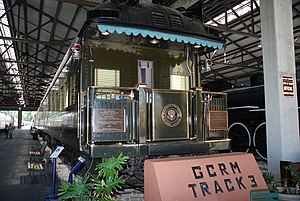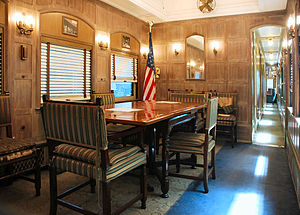
The Pullman Company, founded by George Pullman, was a manufacturer of railroad cars in the mid-to-late 19th century through the first half of the 20th century, during the boom of railroads in the United States. Through rapid late-19th century development of mass production and takeover of rivals, the company developed a virtual monopoly on production and ownership of sleeper cars. During a severe economic downturn, the 1894 Pullman Strike by company workers proved to be a transformative moment in American labor history. At the company's peak in the early 20th century, its cars accommodated 26 million people a year, and it in effect operated "the largest hotel in the world". Its production workers initially lived in a planned worker community named Pullman, Chicago.
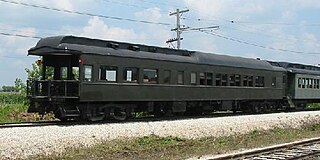
An observation car/carriage/coach is a type of railroad passenger car, generally operated in a passenger train as the rearmost carriage, with windows or a platform on the rear of the car for passengers' viewing pleasure. The cars were nearly universally removed from service on American railroads beginning in the 1950s as a cost-cutting measure in order to eliminate the need to "turn" the trains when operating out of stub-end terminals.
A whistle stop or whistle-stop tour is a style of political campaigning where the politician makes a series of brief appearances or speeches at a number of small towns over a short period of time. Originally, whistle-stop appearances were made from the open platform of an observation car or a private railroad car.

The M-10000 was an early American streamlined passenger trainset that operated for the Union Pacific Railroad from 1934 until 1941. It was the first streamlined passenger train to be delivered in the United States, and the second to enter regular service after the Pioneer Zephyr of the Chicago, Burlington and Quincy Railroad.

In political studies, surveys have been conducted in order to construct historical rankings of the success of the presidents of the United States. Ranking systems are usually based on surveys of academic historians and political scientists or popular opinion. The scholarly rankings focus on presidential achievements, leadership qualities, failures and faults. Popular-opinion polls typically focus on recent or well-known presidents.
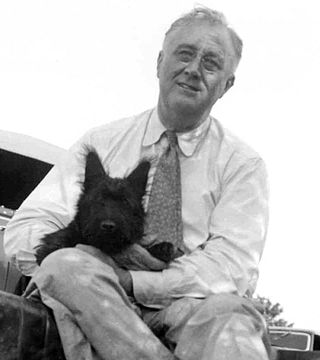
Fala, a Scottish Terrier, was the dog of United States president Franklin D. Roosevelt. One of the most famous presidential pets, Fala was taken to many places by Roosevelt. Given to the Roosevelts by a cousin, Fala knew how to perform tricks; the dog and his White House antics were mentioned frequently by the media and often referenced by Roosevelt and his wife Eleanor. Fala outlived Roosevelt by seven years and was buried near him.
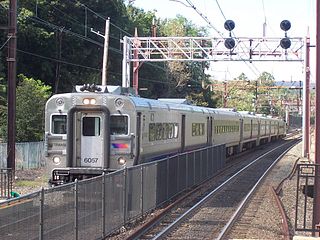
The Comet railcar is a class of locomotive-hauled railcars that was first designed in the late 1960s by Pullman-Standard as a modern commuter car for North American rail lines. Later, the Comet moniker was adopted by NJ Transit for all of its non-powered single level commuter coaches. Additional series of cars bearing the Comet name, based on the original design, have since been built by Bombardier Transportation and Alstom. The successful design was adopted by numerous commuter agencies.

The United States presidential state car is the official state car of the president of the United States.

A private railroad car, private railway coach, private car, or private varnish is a railroad passenger car either originally built or later converted for service as a business car for private individuals. A private car could be added to the make-up of a train or pulled by a private locomotive, providing privacy for its passengers. They were used by railroad officials and dignitaries as business cars, and wealthy individuals for travel and entertainment, especially in the United States. They were sometimes used by politicians in "whistle stop campaigns". Pay cars with less opulent sleeping and dining facilities were used by a paymaster and assistants to transport and disburse cash wages to railway employees in remote locations without banking facilities.

McCormick-Stillman Railroad Park is a 30-acre (12 ha) railroad park located in Scottsdale, Arizona. It features a 15 in gauge railroad, a Magma Arizona Railroad locomotive, a railroad museum, three model railroad clubs and a 7+1⁄2 in gauge live steam railroad.

The United States government has maintained a variety of vehicles for the president. Because of the president's role as commander-in-chief, military transports are exclusively used for international travel; however, the civilian Secret Service operates the president's motorcade.

Gallup was the first polling organization to conduct accurate opinion polling for United States presidential elections. Gallup polling has often been accurate in predicting the outcome of presidential elections and the margin of victory for the winner. However, it missed some close elections: 1948, 1976 and 2004, the popular vote in 2000, and the likely-voter numbers in 2012. The month section in the tables represents the month in which the opinion poll was conducted. D represents the Democratic Party, and R represents the Republican Party. Third parties, such as the Dixiecrats and the Reform Party, were included in some polls.

The Harding Railroad Car is a historically significant Pullman railroad passenger car located at Pioneer Park in Fairbanks, Alaska. Also called Denali, and designated with equipment number X-336 by the Alaska Railroad, the car was one of three used to carry a delegation that included President Warren G. Harding in 1923 to the Mears Memorial Bridge for a ceremony marking completion of the railroad between Fairbanks and Seward. The car was purchased by the Alaska Railroad in 1923 from the Great Northern Railroad, and was used in its service until 1945. At the urging of the Fairbanks "igloo" (chapter) of the Pioneers of Alaska, the car was restored in 1959–60 and given to the city of Fairbanks. It was placed in Alaskaland in 1967, created to mark the centennial of the Alaska Purchase. It was used for some years as the park's visitor center.
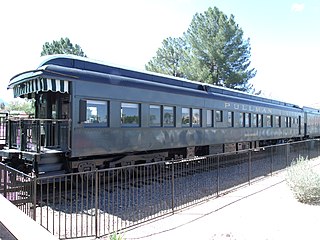
Named after the Norwegian explorer, the Roald Amundsen is a former Pullman Company private car; the last of seven Explorer-series cars built between 1927 and 1929 for the Pullman Company's pool of passenger cars. It was frequently used as the United States Presidential Rail Car, and was used for every president from Herbert Hoover through Dwight Eisenhower.

The presidential transition of Dwight D. Eisenhower began when he won the United States 1952 United States presidential election, becoming the president-elect, and ended when Eisenhower was inaugurated at noon EST on January 20, 1953.
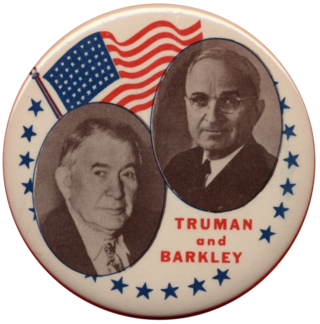
In 1948, Harry S. Truman and Alben W. Barkley were elected president and vice president of the United States, defeating Republican nominees Thomas E. Dewey and Earl Warren. Truman, a Democrat and vice president under Franklin D. Roosevelt, had ascended to the presidency upon Roosevelt's death in 1945. He announced his candidacy for election on March 8, 1948. Unchallenged by any major nominee in the Democratic primaries, he won almost all of them easily; however, many Democrats like James Roosevelt opposed his candidacy and urged former Chief of Staff of the United States Army Dwight D. Eisenhower to run instead.
